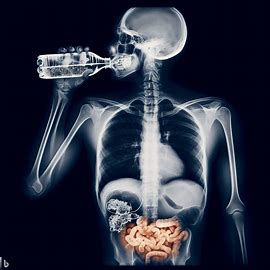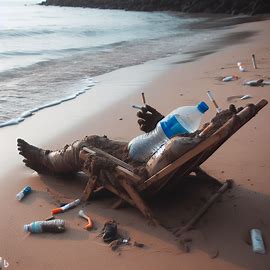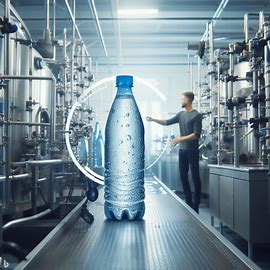Unveiling the Hidden Hazards of Bottled Water: A Closer Look at the Risks and What You Can Do
Bottled water has long been marketed as a convenient and seemingly pure alternative to tap water. However, beneath its crystal-clear facade lie environmental, health, and ethical concerns that are often overlooked, this seemingly harmless choice can harbor numerous dangers that consumers need to be aware of. Nu Origins aims to shed light on the dangers associated with bottled water and provide practical steps to avoid its detrimental effects.From inadequate regulations to concerning health implications, the following revelations expose the dark side of the bottled water industry.
Regulatory Disparities
The regulatory framework governing bottled water differs significantly from that of municipal water systems. Municipalities are obligated to promptly inform consumers of any water contamination that poses an immediate health risk. Unfortunately, bottled water companies do not adhere to the same stringent safeguards. The Environmental Protection Agency (EPA) notes that the bottled water industry largely operates on a self-policing basis, relying on companies to conduct their own tests without consistent oversight.
Ethical Considerations
Exploitation of Resources: The bottled water industry often exploits local water sources, leading to water scarcity in communities where water is bottled for profit. This raises ethical questions about the commodification of a basic human necessity.
Corporate Control: A handful of multinational corporations dominate the bottled water market, creating a concentration of power over this essential resource. This control can lead to price manipulation, unequal distribution, and a lack of accountability in the industry.
Environmental Impact
Plastic Pollution:
One of the most glaring issues with bottled water is the environmental impact of plastic pollution. The production, transportation, and disposal of plastic bottles contribute significantly to the global plastic crisis, harming marine life, ecosystems, and human health.
Carbon Footprint:
The manufacturing and transportation of bottled water contribute to carbon emissions. The extraction and production of plastic bottles, as well as the energy required for transportation, result in a substantial carbon footprint that exacerbates climate change.
Health Concerns
Chemical Leaching: Plastic bottles often contain harmful chemicals like bisphenol A (BPA) and phthalates, which can leach into the water, especially when exposed to heat or sunlight. These chemicals are known endocrine disruptors and have been linked to various health issues, including hormonal imbalances and reproductive problems.
Phthalates and Trihalomethanes:
Microplastics: Recent studies have found that bottled water may contain microplastic particles, which are tiny plastic fragments that can enter the human body. The long-term health effects of consuming microplastics are not fully understood, but their presence in bottled water raises concerns.
A 2018 study examining 259 bottled waters globally found that a staggering 93% contained “microplastic” synthetic polymer particles. Nestlé Pure Life, one of the popular brands, had a sample with over 10,000 microplastic particles per liter. While the health effects of consuming microplastics are not fully understood, research suggests a correlation between plastic exposure and various health hazards, including cardiovascular disease and cancer.
The study also revealed the presence of phthalates, substances associated with an increased risk of cancer, in bottled water across 21 countries. Trihalomethanes, considered carcinogenic, were also detected in certain bottled water brands at levels exceeding industry standards. The long-term health implications of exposure to these chemicals through bottled water consumption remain a concern.
Mold Infestations:
Mold, often invisible to the naked eye, can lurk in bottled water. Cases of mold-related recalls, such as the 2017 Comforts FOR BABY’s Purified Water, highlight the potential health risks associated with mold contamination. The necessary measures to prevent mold in water supplies, particularly during warmer months, need to be implemented consistently.
E. coli Contamination:
The presence of E. coli, a potentially deadly bacteria, has been detected in bottled water. Instances of contaminated water being bottled and distributed without proper follow-up testing have been reported. This lack of vigilance poses serious health risks, emphasizing the need for more stringent monitoring and accountability in the bottled water industry.
How to Avoid the Dangers:
 Choose Sustainable Alternatives:
Choose Sustainable Alternatives:
Invest in a reusable water bottle made from materials such as stainless steel or glass.
Utilize water filtration systems to improve the quality of tap water at home.
Support Local Water Initiatives:
Advocate for and support local water infrastructure projects that provide clean and accessible water to communities.
Raise Awareness:
Share information about the environmental and health risks associated with bottled water to raise awareness among your community and encourage responsible choices.
Advocate for Regulations:
Support and advocate for regulations that promote sustainable packaging practices and restrict the use of harmful chemicals in bottled water production.
When it comes to choosing a safe water bottle, there are several options available. Glass and stainless steel bottles are the safest and most durable. Glass is non-toxic and provides a “purify of taste” benefit, while stainless steel is toxin-free, durable, and provides taste resistance and isolation benefits
If you’re looking for a unique and safe water bottle that purifies water, even from undrinkable sources, you can consider the following options:
- **GRAYL GeoPress purifier**: This is an incredible bottle that purifies water from viruses and bacteria. It will remove nasty things such as pesticides, chemicals, heavy metals, and even microplastics. It is an ideal choice if you travel (or live) in an area with undrinkable water. It comes in a few sizes – 16.9 oz (500 ml) and 24 oz (710 ml) .
- **Brita Water Bottle**: This is a double-wall, filtering, and insulated 20 oz stainless steel bottle. It includes a carbon filter, which reduces chlorine and improves the taste and odor of the water. The filter lasts about 2-3 months, so you have to change it. Their stainless steel bottles should be hand-washed with mild soap .
- **Crazy Cap UV Bottle**: This bottle will purify water from any water source, which makes it another great, healthy, and safe choice. It eliminates microbes and germs with a push of a button! .
If you prefer plastic-free water bottles, you can consider the following options:
- **Yomious Glass Bottle**: This bottle is made of high-quality borosilicate glass and comes with a silicone sleeve that provides a non-slip grip and protects the bottle from breaking. It is also dishwasher safe.
- **Klean Kanteen Water Bottle**: This bottle is made of 18/8 stainless steel and comes with a leak-proof cap. It is also dishwasher safe.
It’s important to note that reusable plastic water bottles are good to drink from if they have a BPA-free tag. However, it’s best to avoid plastic bottles altogether if possible.
While the allure of bottled water lies in its perceived cleanliness and convenience, the aforementioned risks underscore the importance of informed consumer choices. Opting for reusable alternatives, advocating for stricter regulations, and staying vigilant about the quality of bottled water are crucial steps in mitigating these hidden dangers. As consumers, being well-informed empowers us to make choices that not only prioritize our health but also contribute to a more responsible and sustainable future.






